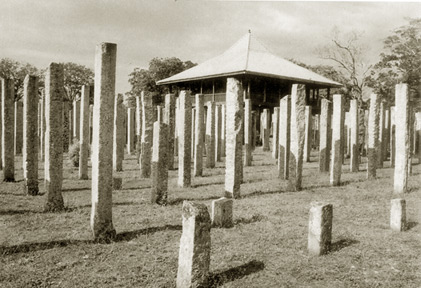King Dutugemunu's gracious gift to Maha Sangha
by Dr. Siri Nissanka Perera
As mentioned in the Mahawamsa King Devanampiyatissa visited the
Mahamevuna Park with some Bhikkhus and devotees when Arahat Mahinda
arrived. Thousands of saman and jasmine flowers were strewn in the park
and the whole area was covered with the fragrance of flowers. The minds
of the devotees were calm and serene. Arahat Mahinda amid the peaceful
atmosphere walked up to the historical place Mahamachulaka and made a
forecast. King Devanampiyatissa got it written in a golden leaf and kept
it safely in the palace.
The forecast was that a Poya House would be built at Mahamachulaka
and it would be the abode for the novices and Arahats alike.
|

A view of the Lova Maha Paya today |
After the reign of King Devanampiyatissa, several other kings ruled
the country. For some time the island was under the rule of Cholas.
After King Dutugemunu united the country, he found the “Gold Leaf” safe
in the palace.
Stability
A country should have political and economic stability. Technologists
and engineers are needed to implement cultural and religious activities
on a large scale.
The Mahawamsa, written by Ven. Mahanama Thera about 600 years after
the reign of King Devanampiyatissa, mentions that the plan for the Lova
Maha Paya was brought from heaven. But if we consider the real state of
affairs, we find that there were efficient craftsmen who were very
competent in engineering and technology. During the period of King
Dutugemunu their work was highly appreciated by the King.
As the Mahawamsa reveals Lova Maha Prasada comprises nine storeys.
Its length, width and height were 100 cubic each. It had four main
entrances. Each storey had 100 rooms and ten store rooms. Lovamahapaya
would have been a magnificent building. As the Mahavamsa reveals it had
nine storeys with 900 apartments covered with plates of copper tiles.
Once it had been the chief monastery of Mahavihara Bhikkhus. The first
floor of the building accommodated worldling (pruthagjana) Bhikkhus; the
second floor by those who had entered the first stage of Sovan, the
third Sakadagami, the fourth Anagami and the fifth Arahat.
Lovamahapaya
After the construction of Lovamahapaya the King was so happy that he
wanted to deliver a Dhamma sermon to the first floor Bhikkhus. The king
realised that it was not an easy task. Lovamahapaya also consisted of
beautifully decorated domes, balconies and dormitories. There were
engraved pillars as well. At the entrance to the building figures of
gods, lions and other animals had been sculptured. The tiles used for
the roof were also made of copper. The manufacture of the tiles may have
been the result of the advanced technology used in the metal industry.
Copper tiles have been found in many excavation sites in Anuradhapura
which proves that there had been tiles made of copper and they were used
for the roof of the building. The historical information found in
chronicles have been proved by the archaeological findings and it
confirms that the people were engaged in the construction work. After
the construction work was over, Lova Maha Prasadaya was offered to the
Bhikkhus at a ceremony.
Today, when we walk towards Ruwanweliseya from the Sri Maha Bodhi,
the ruins of the Lova Maha Paya can be seen on our right. There were
about 1,600 stone pillars in the complex. Some scholars believe that the
building must have been constructed on the pillars. Prof. A.V. Suraweera
however says the building was not erected on the pillars. He says that
the ground floor which consisted of several rooms was for the use of
pruthgjana (ordinary) Bhikkhus.
He also says that the first five storeys were reserved for the
Bhikkhus conversant with the Tripitaka and the rest for the use of
Arahats. If the ground floor of the Lova Maha Prasadaya had thousands of
stone pillars at the initial stage as it is seen today. The inclusion of
residential areas for the Bhikkhus and preaching halls would not have
been possible.
Overjoyed
King Dutugemunu was overjoyed when the Lova Maha Paya was completed.
The Mahawamsa in its description of the Lova Maha Paya says that a
golden stage was erected at the centre of the building and pillars were
used as a part of artistic decorations.
During King Saddhatissa's reign the Lova Maha Paya had caught fire
and he renovated it. The Mahawamsa says it was renovated again by King
Gotabhaya. He used new stone pillars in the renovation. According to
Prof. Suraweera says King Parakramabahu the Great renovated it again
using 1,600 stone pillars.
According to the archaeological analysis of Prof. Suraweera the stone
pillars were added at a later stage during renovations done by various
kings at different times.
Although Lova Maha Paya is included in the eight places of religious
importance (Atamasthana) in Anuradhapura, there is hardly any devotee
who makes offering to it.
Support
According to the chronicles King Dutugemunu offered the Prasadaya to
Bhikkhus as a mark of respect for their tremendous support extended in
his endeavour to save the country from the invaders.
The Thupawansa says “King Dutugemunu who had heard that preaching the
noble doctrine of the Buddha surpasses all other meritorious deeds, got
about 76 million Arahats and other Bhikkhus to chant Maha Managala Sutta
and later appointed a person conversant with Dhamma to preach it to
villagers.
King Dutugemunu, the brave national hero lay on the special stage
erected on the left of the Lova Maha Paya and to the right of
Ruwanweliseya, contemplating on the meritorious deeds he had done while
looking at the gods and the heavenly chariots driven by gold-hued horses
brought from the heaven Thusitha to take him before breathing his last.
The writer is a former Cultural Assistant Director. |

